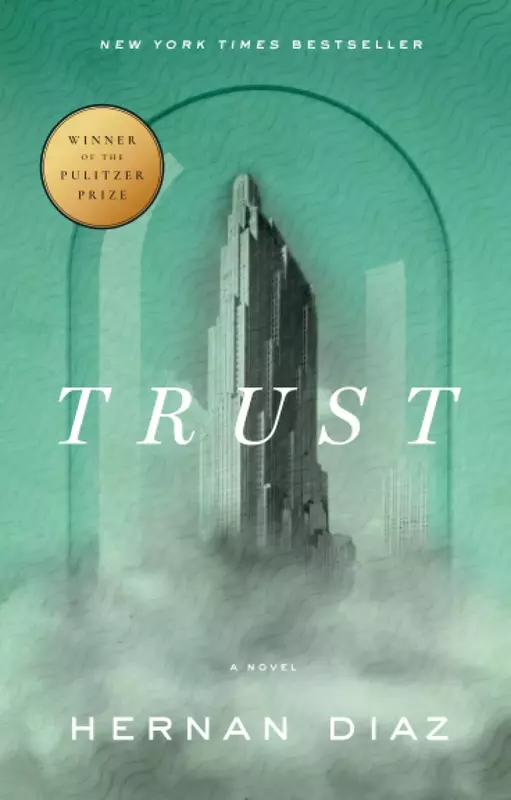This post may contain affiliate links. Read more here.

Note: the following discussion guide contains spoilers, as well as references to critical plot points and the conclusion of Trust by Hernan Diaz.
Trust, a novel by Hernan Diaz published in 2022, delves into the life of Andrew Bevel, a financier who rises to immense wealth by betting against the 1929 stock market crash.
The book garnered attention by being longlisted for the Booker Prize, and it’s the author’s second novel after the success of In the Distance, a finalist for the Pulitzer Prize.
Trust by Hernan Diaz
Structured into four distinct narratives, Trust explores conflicting perspectives on Bevel and his wife. It delves into themes such as the influence of wealth, the intricacies of financial systems, and gender dynamics.
In this guide we will go through the complete summary and ending explanation for Trust by Hernan Diaz.
Have a wonderful book club discussion! ✨
Trust Book Summary
The story starts with a book within the book called “Bonds,” written by Harold Vanner, which is a best-selling novel that parallels the lives of Benjamin Rask and his wife, Helen, with the characters Andrew and Mildred Bevel featured in subsequent sections of Trust.
“Bonds” portrays Rask as an introverted individual who inherits wealth and business acumen, eventually becoming a successful investor after profiting from a market crash. Despite his financial success, Rask remains focused on investing rather than indulging in luxuries.
Helen, Rask’s wife, hails from a once-wealthy family in New York, now facing financial decline. Her upbringing, marked by her father’s eccentricities and her mother’s struggles, leads her to seek freedom through marriage to Rask.
After World War I, Helen discovers that her father has disappeared from the psychiatric hospital where he was being treated. Despite efforts to locate him in Europe, he remains missing, leaving Helen devastated.
In response, she immerses herself in philanthropy, becoming a patron of the arts and supporting mental illness research, an interest she shares with Rask. Although they admire each other, their relationship lacks passion.
As the crash of 1929 looms, Rask anticipates it and profits greatly by betting against the market, while the rest of the country suffers through the Great Depression. Accused by the media of manipulating the crash, Rask remains indifferent to the widespread hardship. While the Rasks face social ostracism, Rask gains even more prominence on Wall Street.
Meanwhile, Helen, feeling guilty over her husband’s actions, dedicates herself to organizing economic relief efforts. Her mental health deteriorates, fearing she may suffer the same fate as her father.
Eventually, she requests to be admitted to the same Swiss psychiatric hospital as him. Under Dr. Frahm’s care, she experiences some improvement with holistic treatment, despite Rask’s skepticism.
However, when Rask plans to have her transferred to a facility under his control, Helen deteriorates rapidly. Rask dismisses Dr. Frahm and replaces him with his own doctors, who administer experimental treatment involving inducing convulsions, which tragically results in Helen’s death.
Returning to New York, Rask finds that his wife’s death doesn’t significantly alter his life. Despite continuing to invest, he never achieves the same level of success as before. He resigns himself to a solitary existence, convinced that he genuinely attempted to live a life beyond investing.
The narrative then shifts to Andrew Bevel’s autobiography, penned by Ida Partenza, though it remains unfinished due to Bevel’s death. In it, Bevel seeks to present a more positive image of himself than portrayed in Vanner’s novel. He describes himself as a New York financier driven by a combination of interpersonal skills and mathematical acumen inherited from his ancestors.
Bevel emphasizes his belief in aligning self-interest with the common good, viewing his investments as a service to society. He depicts his wife, Mildred Howland, as a nurturing homemaker, though subsequent books reveal her significant role in his successes.
Mildred’s untimely death from cancer profoundly affects Bevel, prompting him to continue her charitable work in her memory.
In 1985, Ida Partenza revisits the Bevel mansion in search of the truth about the Bevels, a mystery she never fully understood. Flashing back to 1938, Bevel hires a young and struggling Partenza as the ghostwriter for his autobiography. He pays her generously to shape his story, particularly to downplay the significance of Mildred, Bevel’s wife, and make him appear superior.
Exploring Mildred’s former rooms, Partenza discovers a side of her that contradicts Bevel’s portrayal of her as a simple homemaker. Partenza realizes she’s aiding Bevel in erasing the true Mildred from history, especially after discovering that Bevel had Vanner’s work removed from the New York Public Library.
Before they finish the autobiography, Bevel dies suddenly from a heart attack. Partenza later becomes a successful writer and journalist. In 1985, during her return to the Bevel mansion, she finds Mildred’s journal, “Futures,” chronicling her time in a Swiss psychiatric hospital.
Mildred’s journal reveals the truth: she, not Bevel, was the mastermind behind their investments. Initially, they worked together, with Bevel providing the funds and Mildred devising the strategies. However, their collaboration became imbalanced, leading to tension between them.
Learning of her terminal cancer, Mildred decides to short the stock market, a move that secures Bevel’s status as a top investor. She arranges for hospice care in Switzerland and continues to guide Bevel’s investment decisions until her passing, tired of managing his ego but reconciled to their partnership in her final days.
Trust Book Ending Explained
So, what happens at the end of Trust?
First, lets talk about the final novel, “Futures”. In “Futures,” Mildred Bevel’s journal entries from her time at a Swiss psychiatric hospital while battling cancer offer a contrasting perspective on her life with Bevel compared to what was presented in earlier books. The entries are short and often lack dates, marked only by the time of day she wrote them.
Mildred recalls her life with Bevel in fragments. The initial years of their marriage lacked passion until Mildred’s successful investment in philanthropy in 1922 sparks a change. When Bevel tries to replicate her success and fails, they begin collaborating on investments. Mildred teaches Bevel to think creatively, but he struggles to understand her innovative strategies and feels emasculated by his reliance on her guidance.
In 1926, Mildred discovers a way to exploit stock market inefficiencies, but Bevel secretly manipulates the market for his gain, leading to a rift between them. During their two-year estrangement, Bevel’s investments become conservative while Mildred focuses on music and philanthropy.
Mildred predicts the 1929 market crash but conceals her terminal cancer diagnosis from Bevel until after the crash. She continues directing his investments while battling her illness, even as Bevel takes credit for her success. As her health deteriorates, Mildred regrets not allowing Bevel to take charge and struggles with his inability to understand her feelings.
Throughout her hospitalization, Mildred reflects on her childhood memories and the nature of journaling. She finds parallels between the church bells’ logic and the stock market, using musical analogies to explain her investment strategies. As her journal entries become more fragmented, Mildred finds solace in nature as she approaches the end of her life.
Overall, the final part of the novel, Book 4 of Trust, introduces a new narrative style through Mildred’s diary, which blends fragmented memories and stream of consciousness. This fragmented form challenges readers to piece together its contents and apply the revelations to the conflicting narratives presented in the preceding books, akin to a detective solving a case.
While the earlier books instilled a sense of skepticism towards tidy narratives, this final book re-establishes trust through its raw and seemingly unguarded style.
One significant aspect of Mildred’s diary that reverberates throughout the other books is her definition of kitsch in relation to La Fiesolana, a Tuscan-style vacation home Bevel claims she adored. But she actually hates it because it’s a copy of Tuscan architecture.
She calls this type of copy “kitsch,” saying it values looking like the original more than being original. This idea of kitsch connects to the theme of storytelling and finance being like fake copies of reality.
Bevel’s infatuation with La Fiesolana shows he can’t tell real from fake. He presents himself as intellectually deep, but Mildred sees through this façade, noting that he mistakes uncertainty for profundity and indecision for thoughtful analysis. His grasp of the world, particularly in the realm of investments, is superficial.
He attempts to replicate Mildred’s success using a copied strategy, resulting in a hollow and artificial symmetry devoid of genuine passion, much like a player piano mechanically reproducing music without the soul of a skilled pianist.
Mildred’s diary seems like it holds the truth missing from earlier books. But like them, Futures isn’t straightforward. It’s written without an audience, which makes readers trust it more.
Since it’s the last part of Trust, readers expect it to solve the mystery, like in detective novels where the killer is revealed. Trust, with its surprises and false leads, puts readers in the role of detectives, expecting the final section to unlock the secrets of Bevel and Mildred’s life.
How did you like the ending of the novel? Happy reading! ❤️

Ginny Kelley
Monday 1st of January 2024
I was a little skeptical about the novel in the beginning, but it soon grabbed me and I was intrigued. Some sentences I found having to reread as I did not want to miss the “meaning “. The characters a true representation of gender roles, especially at the turn of the century. I particularly felt saddened by the two wives roles, who were portrayed as rather weak characters, but far from the truth. Ida was a complex protagonist and played many roles. I enjoyed reading about her character. What started out slowly for me, I found that half way through I was binge reading to find out what would happen. Good read